
http://www.kindamuzik.net
ernaast
Onze laatste liverecensie.
Onze laatste albumrecensie.
Ons laatste interview.
Onze laatste video.
Miles Ahead
A couple of weeks ago, Omar Muñoz-Cremers provided an in-depth review of 'Miles Beyond', a book that described MILES DAVIS' most controversial electric period. Because we from KindaMuzik happen to be great admirers of the jazz legend, we now once again have a feature on the master: As it's been ten years since Miles died on 25 September 1991, Bas Ickenroth wrote a comprehensive musical biography by highlighting the ten best and most influential MILES DAVIS albums. Dig it, you cats!
Tekst: Bas Ickenroth
Publicatiedatum: 11 september 2001
 BIRTH OF THE COOL (1950)
BIRTH OF THE COOL (1950)
Miles Dewey Davis III is born 26 May 1926 in Alton, Illinois, but grows up in East St. Louis in a relatively prosperous family. He begins to play the piano and the trumpet at a young age, and during his puberty his talents show all too well, and he starts to get quite a name as a jazz trumpet player in East St. Louis. By the age of 18, that city becomes too small for him, so he decides to head to New York. In St. Louis he had become acquainted with Charlie 'Bird' Parker and Dizzy Gillespie when they were playing in some clubs there, and both regard him as truly talented. When Miles arrives in New York in 1945, the first few years he plays with aforementioned inventors of bebop on many occasions, who both inspire him deeply. Especially Bird is a great influence on the young Miles. However, the fast and often furious form of jazz that bebop is, is not one of Miles' strongest points. Many trumpet players exceed him in speed and technique, and those years prove to be quite difficult for him. As a result, he begins to develop his own style, based on feeling and sensitivity rather than on speed and technique, and his almost vibrato-less and emotive tone is a true revelation between all of the fast players. Much of that style was developed during his years with Bird (Check out Miles' solo in 'Now's the Time' from 1945), and the contrast between Bird's fast and explosive saxophone and Miles' more relaxed playing works out tremendously. Miles, however, forms his own band in the late 40s, a nonet with, among others, Max Roach on drums and Gerry Mulligan on baritone sax. In this nonet, Miles already shows a great deal of courage by putting (for a small jazz group) unusual instruments like French Horn, tuba, and baritone sax in the group. With this nonet he records twelve songs between 1948 and 1950, which are first released as six single 7" releases. It isn't until 1957 when the songs are combined on one album, but by then Miles himself is beginning to change his style once again. But around 1950, he reacts against the constantly faster-playing in bebop with much funkier, slower, and more melodic versions of standards and originals, and thus creates the birth of a new kind of jazz: the cool jazz. When comparing the Miles from 1945 and the Miles from 1950, one can see a huge growth in technique, but he never uses that technique to show off, he only uses it to develop his own style to his utmost abilities. Those abilities can be observed on this wonderful collection of songs, and this album marks his first succesful attempt at changing the complete style with his radical inventions. Later in 1950, he records a great session with Sarah Vaughan, a session in which he displays that his emotive playing style combines superbly with the melodic voice of Sarah Vaughan. After these sessions he slips into his first real drug addiction, and for a few years he records almost nothing, and he only plays live to finance his addictions. It isn't until 1954 that he comes up with a great album as a bandleader, an album called 'Walkin''.
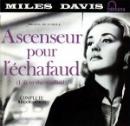 ASCENSEUR POUR L'ÉCHAFAUD (1957)
ASCENSEUR POUR L'ÉCHAFAUD (1957)
The mid-50s mark the start of his first great quintet featuring Red Garland, Paul Chambers, Philly Joe Jones, and the later truly magnificent John Coltrane on tenor sax. On 'Walkin' from 1954 this quintet doesn't play yet, but the album is the return from Miles after his addiction. The quintet begins to play around 1955 together, and records four entire albums in two recording sessions in 1956. All great, all quite relaxed-sounding, and all full of beautiful improvisations and solos of all bandmembers. It takes Miles' popularity to a much higher level, and now he is regarded as the best trumpeter and bandleader around. It is after these albums that Miles gets invitations to play on his own in Paris, and when he arrives at the airport he is waited for by Louis Malle, a French film director. Malle, a great Miles Davis fan asks him to record a soundtrack for his new movie 'Ascenseur Pour L'échafaud'. Miles agrees and goes into a studio and improvises and records the entire score within two successive nights, with the help of a couple of French jazz musicians. He improvises while watching the film, which is being projected onto the studio wall. It is during these sessions he discovers the melancholic touch his playing has, and the result is truly remarkable: Miles doesn't play standard jazz songs, he chooses almost themeless pieces of music to improvise over, and the album sounds so incredibly intimate and bluesy that some passages are almost painful to listen to. As if he wants to get rid of all his negative impressions and relationships from the early 50s in two nights, his trumpet sounds so direct and emotional that you can almost feel the air coming out of the instrument, blowing in your face. The fact that he shows his playing speed in two short pieces, which are almost bebop-like, proves that he isn't untouched by the critique he got during the years before. He is the first to use such themeless and modal sounding songs, and here he lays the foundation for what is to become the ultimate jazz record of all time, 'Kind of Blue'. 'Ascenseur Pour L'échafaud' is first released as one side of 'Jazz Track', with 'Green Dolphin Street' on the other side, but it was re-released as an entire album with many previously unreleased takes in the early 90s.
 KIND OF BLUE (1959)
KIND OF BLUE (1959)
While recording some great albums with the above-mentioned quintet, Miles decides to add another saxplayer to the line-up, Julian 'Cannonball' Adderley, and his bluesy contributions contrast beautifully with the more experimental Coltrane improvisations. Also, he replaces Philly Joe Jones for Jimmy Cobb on drums and Red Garland for Bill Evans, and later Wynton Kelly. Especially Bill Evans, the only white man in this ensemble, is going to have a great impact on 'Kind of Blue'. In some sort of the same vein as 'Ascenseur Pour L'échafaud', the songs on this album are full of feeling and emotion, don't have long themes to come back to after a solo, and are much more open and transparent to play on and to listen to. The whole structure, not only the songs but also the used notes and scales, is new and daring, and at the same time perfectly logical. This is the second time that Miles changes jazz music single-handedly, with the big difference that the whole world is watching, because of his enormous popularity. The songs he writes for 'Kind of Blue' are instant classics, and many of those themes are still played today, as shown by Chick Corea and Bobby McFerrin with 'All Blues' at the latest North Sea Jazz Festival, but also by acts like Motorpsycho with 'So What' in their improvisations. The impact from the album stays enormous even in these times, and this is probably also related to the nearly perfect sound and production: Even 42 years after being first released, it still sounds as though it was recorded yesterday. Perhaps it's also the perfect balance between recognizable melody and pure improvisation that makes 'Kind of Blue' so special. There isn't a note too many on the album, and that can't be said of many jazz records. Everything here is essential, everything is magic, everything is that proverbial pot of gold at the end of the rainbow. If you decide to buy only one jazz record in all of your life (but you wouldn't be that stupid of course), this is the one.
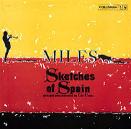 SKETCHES OF SPAIN (1960)
SKETCHES OF SPAIN (1960)
These are fruitful years. Not only the above two albums are instant classicw; Miles also manages to record three orchestral big band albums with Gil Evans, who also worked with him on the arrangements of 'Birth of the Cool' and with whom he stayed friends with all his life. The fact that 'Sketches of Spain' is mentioned here, and not 'Miles Ahead' and 'Porgy and Bess', is purely a personal choice; the quality is equally high on all albums. 'Sketches of Spain' is the last of the three big band albums, and here the focal point is the adagio from 'Concierto de Aranjuaz for Guitar and Orchestra' by Spanish composer Joaquin Rodrigo. The composition becomes a breathtaking experience by Evans' orchestral arrangements and Miles' infinitely subtle trumpet; it is simply astounding which impact jazz can have on European classical work. The other pieces on this album are mostly from Gil Evans' hand, and he has this great ability to absorb all of these musical influences in which he choses to dive into. His composition 'Solea' shows this in all its unique glory: Spanish-influenced melodies, beautiful arrangements, and a very hypnotising, almost trance-like, rhythm. John Coltrane is obviously influenced by this piece of music when he writes his equally incredible and Spanish-spiced 'Olé'. And while the orchestra plays superbly and vividly, they also compliment the flamenco and blues outbursts from Miles in an almost unprecedented way.
 FILLES DE KILIMANJARO (1968)
FILLES DE KILIMANJARO (1968)
The early 60s mark the ending of the great quintet (later sextet), and they are not the easiest nor the most creative years for Miles Davis. It is the beginning of the free jazz, and that's not a genre that Miles is particularly fond of. Since Ornette Coleman started that movement in 1959, jazz becomes more free in melody, rhythm, and tonality, to the point that the end result seems chaotic, structureless, and without rules. Seems, because the free jazz definitely has rules, they are only hardly detectable by Joe Public. Miles, however, finds the new and revolutionary approach to jazz not worth listening to. He respects Coleman, but when the latter begins to play the trumpet without any training, Miles is disgusted. When he has a listening session for a jazz magazine, he reacts on a piece by Eric Dolphy: "Is this Eric Dolphy? It has to be, he is the only one who plays this ugly." And even John Coltrane, Miles' long time collaborator and good friend, makes albums Miles dislikes from the start. He calls free jazz "noise for noisesake" and turns his back to all the people who jumped on the free jazz train. Around 1964, Miles forms his new band, known later as the second great quintet, with Wayne Shorter on sax, Ron Carter on bass, Herbie Hancock on piano, and the then just 18-year-old Tony Williams on drums (who, by the way, played in that same year on the utterly great Eric Dolphy record 'Out to Lunch'). With them, Miles records a couple of great albums, but just like the pure free jazz records, they are not easily accessible. Miles creates his own version of a more free form of jazz (Critics call it freebop.), without letting the music subside into total freedom. The often estranging melodies and the ferocious speed with which Tony Williams leads the band make albums like 'Sorcerer' and 'Nefertiti' difficult and tough, and the absence of truly memorable melodies and hooks result in great but no classic albums. Instrumentally this is the most advanced band Miles has ever had, and the concerts in this period are without any doubt daring, on the edge, and extremely good. Strangely enough the only classic albums this quintet makes are the so-called transitional albums, 'Miles in the Sky' and especially 'Filles de Kilimanjaro'. They are transitional in the way that Miles tries to incorporate electronic instruments like the Fender Rhodes piano and the electric bass into the traditional jazz setting before using them constantly in his electric period. On 'Miles in the Sky' it is the opening track that stands out: 'Stuff' shows a groovy and funky rhythm section playing in four, with the soloists playing a theme that lasts for more than five minutes entirely. Herbie Hancock's magnificent rhodes piano backs the whole thing up, while Tony Williams sounds like a controlled madman on his drumkit. The real classic album from this era is 'Filles de Kilimanjaro', which again is filled with both beautiful acoustic and electric piano and a much more relaxed playing ensemble. Strangely enough the album often is regarded as the start of Miles' electric period, while most of the album is still acoustic. The incorporated electric elements blend in a completely natural way, Tony Williams plays some mean funky drums, and Miles himself excels in tremendous improvs, but especially in composing. The melodies are much better and much more memorable than on the albums before, and the music itself is as near to traditional jazz as it is to 60s funk and avantgarde. A definite must-have.
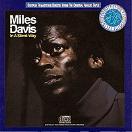 IN A SILENT WAY (1969)
IN A SILENT WAY (1969)
After 'Filles de Kilimanjaro', Miles turns drastically away from the standard (acoustic) jazz line-up, and by doing so he once again creates something completely new and unprecendented in jazz: organs and electric pianos, electric basses and guitars, pure funk drumming, tribal percussion, and of course Miles' trumpet, it all gets involved in a highly symbiotic relationship. On 'In a Silent Way' Miles introduces all of these elements and makes the first album in a style which later will be called fusion. Many of the musicians on this album will be legends of their own a few years later, but they all learn it from the master himself. On this album Herbie Hancock, Joe Zawinul, and Chick Corea all play electric piano or organ, John McLaughlin on guitar, Dave Holland on bass, Wayne Shorter on sax, and Tony Williams on drums. Williams plays in a subtle and groovy way, and much more quiet and less wild than on the albums before. His steady drumming in four is the biggest step away from pure jazz, and although his playing on the hi-hat seems simple, he manages to create a fantastic groove and tension with his minimalistic drumming. The three pianists provide psychedelic, dissonant, almost soundscapesque atmospheres and tremendous solos, and the Joe Zawinul composition 'In a Silent Way' is the quiet highlight of the album. The other titles are from Miles' hand, and they show a deep appreciation for Sly and the Family Stone-funk on one hand, and Karl-Heinz Stockhausens' avantgarde on the other. The funk can be found in the rhythms, the avantgarde can be regarded in the circular movement of the music: It has no apparent start or ending, and it can be listened to endlessly. The fact that longtime producer of Miles' records Teo Macero begins to experiment with cut-and-paste techniques adds original aspects as well. Miles, Wayne Shorter, and John McLaughlin are in the form of their lives on these sessions, and all three musicians play some of their best solos and themes in their entire career. The final result is transparent and subtle, yet demanding on the listener who expects tradional jazz. "Miles sold out" is a very often repeated saying in these years, because many of the critics don't understand his love for the more popular music in that era. But as always, Miles proves them wrong with a whole bunch of classic albums, that are among the most influential ever.
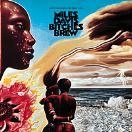 BITCHES BREW (1969)
BITCHES BREW (1969)
While 'In a Silent Way' was a very open and transparent sounding album, this is not the case for his next album. 'Bitches Brew' is Miles' biggest-selling album ever, but don't expect anything easy here. It's a dark and dense album that roots deep in the avantgarde and black music. So, why does it sell this well? The answer maybe lies in the fact that Miles wants to contact the black community once again, after they left jazz to listen more to funk, blues, and rock. He succeeded: From the moment of release the album sold lots and lots, and Miles instantly restored his credibility to both the critics and the buying audience. The music however is as difficult and uncommercial fusion jazz can get: Two drummers and two percussionists create a demanding and powerful groove, the dissonant electric piano and organ parts shift dangerously over and through each other, electric and double bass produce a deep and daring bass backbone, while Miles' trumpet is treated with delay and other effects to create the topping for these exorbitant jam sessions. His solos are shifting between subtle and melodic, and atonal, wild, and chaotic. Just like 'Filles de Kilimanjaro', the album consists of equal parts jazz, funk, and avantgarde, but through the addition of Jimi Hendrix-style rock to this cocktail it becomes something new, daring, completely out of this world. The Complete 'Bitches Brew' sessions are released later in 1999 as a 4CD box, and that box set shows that this may be Miles' most creative period. He demands all and more from his bandmembers, and he is no less demanding on himself. More than on all of the albums before 'Bitches Brew', the album, and also the complete box set, is a display of the abilities and force from the entire band as a whole. No one exceeds above the extremely high level that is present on the whole album, but that would be virtually impossible either. On the complete sessions there are also songs that will appear on evenly great albums like 'Big Fun' and 'Live-Evil', which have the same kind of impact as 'Bitches Brew' itself. That impact can still be felt in today's music, such as post-rock and the avantgarde improv-scene. Without it, those types of music would be non-existent, or totally different from the form they do have today. And even today, there is little music that equals the long space-explorations from Miles Davis from around 1970.
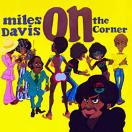 ON THE CORNER (1972)
ON THE CORNER (1972)
Miles Davis continues to dig in his blacks roots, but does keep an open mind for other music as well. For 'On the Corner' he reaches back to two main elements: Sly Stone and Karl-Heinz Stockhausen. As strange as it may seem to blend those two together, Miles succeeds easily. Just like on 'In a Silent Way', but on 'On the Corner' he takes his circular funkrock outfits almost to the extreme. It will be his most controversial album ever, as it is a "So What!" to all the critics who still believe he sold out. The album consists of only two long pieces of music, which both do not have an apparent beginning or ending. Both explore the possibilities of one chord for minutes and minutes, and the emphasis lies rather on the never-stopping rhythm than on melodies and solos, which is enforced by the mix that keeps even Miles' trumpet on a tight leash. It has to be said that the first piece, although it is spiced up by tabla percussion and great guitarwork (by John McLaughlin), is not constantly impressive. The slow funkbeat isn't interesting enough to keep the attention. The other piece is a completely different story, however. It begins with a slow tabla and sitar raga, but when the drums come pounding in, it is clear: Miles has the funk, and let nobody forget it. Those drums - played by Al Foster or Jack DeJohnette, this isn't sure because of the rigorous editing by Teo Macero - may be the first drum'n'bass and breakbeat rhythms ever, and are obviously extremely influential on today's music. Former Aretha Franklin bass player Michael Henderson plays some sober but incredibly funky bass throughout the entire album, and often spices up his playing with the wah-pedal. And that wah-pedal is also one of the new toys for Miles himself: He plays with this effect on more than one occasion during these sessions, and continues to do so over the next few years.
 DARK MAGUS: LIVE AT CARNEGIE HALL (1974)
DARK MAGUS: LIVE AT CARNEGIE HALL (1974)
Over these years, the true force of Miles Davis lies in the unbelievable live events: On stage, the magic is always present, and the audience experiences at most occasions a total blow in the face by the enormous power unleashed by the group. The studio recordings, although being classics in their own way, are not able to capture the complete blitzkrieg Miles pulls off night after night. Many live albums are released during these years, and after 1972 almost every Miles album is recorded live. The live albums ('Black Beauty', 'Live at Fillmore') from around 1970 are wild, harsh, inaccessible, daring, and strangely enough not that much unlike the free jazz Miles despised a couple of years earlier. They are extremely powerful, and although the tracks are named after the songs that appear on albums like 'In a Silent Way' and 'Bitches Brew', they are hardly recognizable due to the total freedom the band has on stage, especially when they are not backing up Miles himself when he plays a solo. On these albums, the distorted Fender Rhodes is always right on top (Chick Corea is totally freaking out here.), but no electric guitars are present. The other way around is the case on 'Dark Magus', a ferocious live album from 1974. Here Miles is much more aware of his black roots, and except for Dave Liebman on sax, the entire band is black. So, no Fender Rhodes, but three electric guitars are taking over. And they're taking over indeed: just like on 'Agartha' and 'Pangaea' from 1975, the guitar solos are ever present in a Jimi kind of way. Absolutely stunning is the combination of Al Foster's steady funk and rock drumming (Listen to 'Moja (Part 2)' where he manages to groove superbly in five.) and Mtume's log percussion. It gives the album a jungle feel, and the overall sound is completely organic and natural, but at the same time so many miles in outer space that earth can't be detected even with the Hubble telescope. Hearing this record makes it all the more unbelievable that Miles gets accused of selling out, because these spacious funk explorations emphasize on researching every possibility of one chord. This may seem boring, but the way it is worked out on 'Dark Magus' is incredibly hypnotic and addictive, and a chord-shift or tempo-change would only diminish the devasting power of these 15-plus-minute grooves.
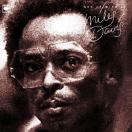 GET UP WITH IT (1974)
GET UP WITH IT (1974)
The last studio album before Miles got into a six-year period of drinking, snorting, smoking, fucking, and not making any music. It's a double album, and not a consistent one, probably due to the fact that the songs come from different sessions from the last four years. 'Maiysha' for instance, is dangerously close to easy listening, and is the least compelling track on the album. Also different is 'Red China Blues', a rhythm & blues song that sounds much more composed and organised than all the songs from the last five years together, but it's still a pretty good song. The other songs are probably the best he ever recorded. Album number one ends with 'Rated X', and even today it can be mixed with every drum'n'bass track in the world. This song is very much ahead of its time, because of the pure drum'n'bass rhythm that sounds so tight it could easily have been programmed by Photek himself. Miles doesn't play any trumpet here, but produces continuous dissonant notes on his Yamaha organ, which makes this song inaccesible as hell. This song will be remixed in the late 90s by the likes of Bill Laswell and Doc Scott, making it a modern drum'n'bass track. 'Mtume', named after the percussionist in the band, is the most African sounding song he ever made, and the tribal rhythms are so hypnotising that one could easily lose himself in these wild and thundering rhythms. The live feel on this song is beyond comprehension, I tell you. But the highlight of the album, and maybe of Miles' entire carreer, is the 32-minute tribute to the just deceased Duke Ellington 'He Loved Him Madly'. Highly meditative and sensitive, this song displays the enormous melancholy in Miles' playing, and it's almost painful to hear such emotions this directly. There is no steady rhythm present for more than ten minutes, but the ambient soundscape produced by drums, organ, flute, bass, and guitar make this an unprecendented listening experience. It's a track which inspires Brian Eno in producing his ambient music, and the influence can easily be heard on all his ambient recordings. When the drums finally begin to play in a slow pace, it almost resembles some sort of triphop avant la lettre, which combines fantastically with the master's unearthly trumpet. The Duke could have gotten no better tribute than this.
After the six year hiatus, Miles Davis begins making music again, but by now the drive to
experiment, to create something completely new, is almost gone. He changed music radically for
more than 25 years in numerous different directions, and it's inevitable that the stream has to
stop sometime. He makes a few pop-jazz albums, which suffer tremendously under the slick 80s
production methods, and his songwriting loses the edge it once had. Also his choice for typical
80s atrocities like 'Time after Time' and 'Human Nature' on his worst record 'You're Under
Arrest' is curious, to say the least. The inspiration is gone, although he himself thinks
otherwise and calls it the best music he ever made. His deteriorating health is audible in his
playing, which lacks the force that he displayed between 1945 and 1975. Finally, in 1991, he dies
from a stroke, ironically after getting terribly angry at a couple of doctors who want to put him
in a hospital. Miles slips into a coma, and never wakes up again. One of the greatest innovators
of the 20th century and beyond dies on 25 september 1991. The music he made will never be
forgotten, and the electric period gets the attention it deserves only just the last couple of
years. This has to do a great deal with Bill Laswell's project 'Panthalassa', where he remixes
some of Miles' music from between 1969 and 1975. Not everyone is enthousiastic about this record,
but I for one think it's absolutely great, and maybe the best starting point for anyone who has
yet to discover Miles' electric period. But every above-described period is definitely worth
checking out, and the mentioned albums are just my personal choice - one could easly opt for any
other record between 1950 and 1975, for they are all classics in their own way.
http://www.kindamuzik.net/achtergrond/miles-davis/miles-ahead/514/
Meer Miles Davis op KindaMuzik: http://www.kindamuzik.net/artiest/miles-davis








Deel dit artikel: